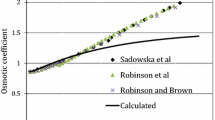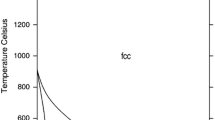Abstract
Thermodynamic modeling of the binary systems Ni(NO3)2–H2O and Ni(NO3)2–H2O and of the ternary system of Fe(NO3)3–Ni(NO3)2–H2O along the 30 °C isotherm are presented. The extended UNIQUAC model was applied for the thermodynamic assessment of the investigated systems, the model parameters were regressed simultaneously using the available databank but with additional experimental data recently published in the open literature. A revision for previously published parameters for the nickel ion, new parameters for the iron(III) nitrate system, and interaction parameters for the Ni2+–Fe3+ interaction are presented. Based on this set of parameters, the equilibrium constants of hydrates were determined. The model represents the experimental data with good accuracy from the freezing point region to the boiling points of the solutions.



Similar content being viewed by others
Abbreviations
- A :
-
Debye–Hückel parameter (kg1/2·mol−1/2)
- K :
-
Equilibrium constant
- a :
-
Activity
- A, B, C, D and E :
-
Parameters of Eq. 12
- aq:
-
Aqueous
- B :
-
Debye–Hückel parameter (kg1/2·mol−1/2)
- I :
-
Ionic strength based on molality
- m :
-
Molality (mol·kg−1 H2O)
- p :
-
Pressure (kPa)
- q :
-
Surface area
- R :
-
Gas constant (J·mol−1·K−1)
- r :
-
Volume parameter
- T :
-
Temperature (K)
- u, u 0, u T :
-
UNIQUAC interaction parameters
- x :
-
Mole fraction
- M w :
-
Molecular weight of water (kg·mol−1)
- n :
-
Mole number
- γ :
-
Activity coefficient
- ∞:
-
Infinite dilution
- 0:
-
Standard state
- *:
-
Asymmetrical
- E:
-
Excess
- I:
-
Index
References
Slick, P.I.: Ferrites for non-microwave applications. In: Wohlfarth, E.P. (ed.) Ferromagnetic Materials, pp. 189–241. North Holland, New York (1980)
Kulilowski, J., Lesniewski, A.: Properties of Ni–Zn ferrites for magnetic heads: technical possibilities and limitations. J. Magn. Mater. 19, 117–119 (1980)
Brockner, W., Ehrhardt, C., Gjikaj, M.: Thermal decomposition of nickel nitrate hexahydrate, Ni(NO3)2·6H2O in comparison to Co(NO3)2·6H2O and Ca(NO3)2·4H2O. Thermochim. Acta 456, 64–68 (2007)
Iliuta, M., Thomsen, K., Rasmussen, P.: Modeling of heavy metal salt solubility using the extended UNIQUAC model. AIChE J. 48, 2664–2689 (2002)
Thomsen, K., Rasmussen, P., Gani, R.: Correlation and prediction of thermal properties and phase behavior for a class of electrolyte systems. Chem. Eng. Sci. 51, 1787–1802 (1996)
Abrams, D.S., Prausnitz, J.M.: Statistical thermodynamics of liquid mixtures: a new expression for the excess Gibbs energy of partly or completely miscible systems. AIChE J. 21, 116–128 (1975)
Maurer, G., Prausnitz, J.M.: On the derivation and extension of the UNIQUAC equation. Fluid Phase Equilib. 2, 91–99 (1978)
Sander, B., Fredenslund, A., Rasmussen, P.: Calculation of vapour–liquid equilibria in mixed solvent/salt systems using an extended UNIQUAC equation. Chem. Eng. Sci. 41, 1171–1183 (1986)
http://www.cere.dtu.dk/Expertise/Data-for-aqueous-salt-solutions (2017). Accessed 26 March 2017
El Goundali, B., Kaddami, M.: H2O–Fe(NO3)3–Ni(NO3)2 ternary system isotherms at 0 and 30°C. Fluid Phase Equilib. 306, 175–180 (2011)
Sieverts, A., Schreiner, L.: Das binare System Ni(NO3)2–H2O und die 25°;-Isotherme des ternaren Systems Ni(NO3)2–HNO3–H2O. Z. Anorg. Chem. 212, 105–112 (1933)
Funk, R.: Über die Löslichkeit einiger Metallnitrate. Z. Anorg. Chem. 20, 393–418 (1899)
Jones, H.C., Getman, F.H.: On the nature of concentrated solutions of electrolytes. Hydrates in solution. Am. Chem. J. 31, 303–359 (1904)
Jones, H.C., Getman, F.H., Bassett, H.P., McMaster, L.: Hydrates in aqueous solution: evidence for the existence of hydrates in solution. Their approximate composition and certain spectroscopic investigation bearing upon the hydrate problem. Carnegie Institution of Washington, Washington (1907)
Andreeva, T.A., Pozharskaya, S.S., Golovanova, T.G.: Properties of solutions of beryllium–nickel nitrate and calcium–nickel nitrate at 25°. Russ. J. Inorg. Chem. 18, 1638–1640 (1973)
Thomsen, K.: Aqueous electrolytes, model parameters and process simulation. PhD Thesis, Technical University of Denmark (1997)
Arrad, M., Kaddami, M., El Goundali, B., Thomsen, K.: Solubility modeling of the binary systems Fe(NO3)3–H2O, Co(NO3)2–H2O and the ternary Fe(NO3)3–Co(NO3)2–H2O with the extended universal quasichemical (UNIQUAC) model. J. Solution Chem. 45, 534–545 (2016)
Author information
Authors and Affiliations
Corresponding author
Rights and permissions
About this article
Cite this article
Arrad, M., Kaddami, M., El Goundali, B. et al. Solubility Modeling of the Systems Ni(NO3)2–H2O and Fe(NO3)3–Ni(NO3)2–H2O with the Extended Universal Quasichemical (UNIQUAC) Model. J Solution Chem 46, 1220–1229 (2017). https://doi.org/10.1007/s10953-017-0639-2
Received:
Accepted:
Published:
Issue Date:
DOI: https://doi.org/10.1007/s10953-017-0639-2




